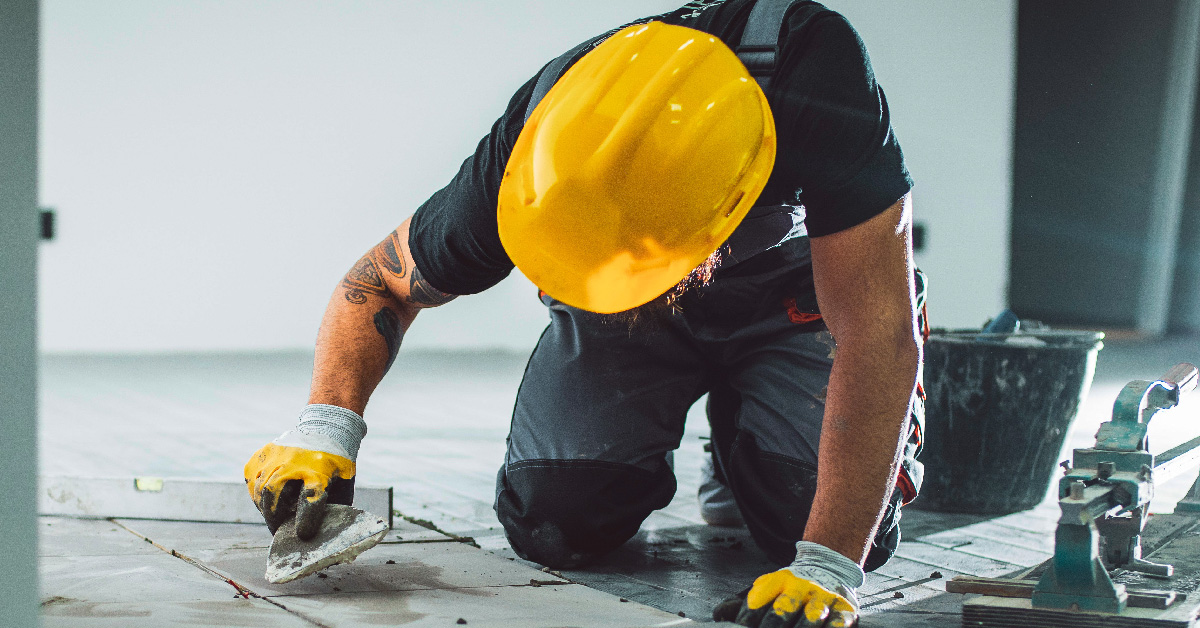Best Practices | Service & Maintenance
From Our Service Dept: The Importance of Properly Maintained Floors


Imagine working in a warehouse with a high volume of daily foot traffic. There are always people on the move, and projects to finish. There are occasional mishaps, materials get spilled, and they get cleaned up quickly (and lightly) because you're in the middle of a big project. You assume that regular maintenance will pick up anything you leave behind later. That is... if there is regular maintenance. Unfortunately, if the floors are not properly maintained, it might not end well. The floor's surface could become slippery, cluttered, or uneven, creating a dangerous environment for workers. Properly maintained floors are important to the safety, protection, and health of your staff.
So, what are the proper protocols to maintain clean, safe floor surfaces? The following are some best practices.
When dealing with vinyl or rubber tiles or a carpet-tiled floor in a high-trafficked building, whether it is an office, with or without cubicles, a permit room, a dining facility, or even a bunk house, you want to care for the floors. If the floors become worn, or if the tiles are starting to curl up in the corners, you want to replace them as quickly as possible. The more dirt and debris that gets between the tiles and mats and the hardwood sub-surface, the less adherence there will be to keep the tiles and mats adhered to the base floor.
If you find a section of the flooring “soft” under your feet (no matter how large or small the person is), call in a professional right away. This softness can commonly happen in:
- the doorways leading to the exterior of the building(s).
- the restroom entrances, by the sinks, showers, or hallways.
- kitchens and dining areas.
- highly utilized hallways.
It does not matter where the softness occurs; it must be addressed right away, and by a professional.
But this is just the start of your concerns. Remember, routine care and maintenance are generally less expensive than repairs and replacement; floors are no exception to that. So, a custom commercial floor cleaning and maintenance plan will pay dividends during the life of the floor.
Some points to keep in mind with any floor surface that you work on:
- Sweep hardwood and tile.
- Vacuum carpet in high-traffic areas.
- Spot-clean spills as soon as possible.
- Use a dust mop or a damp mop. Never soak the floor, and never pour a bucket of water or water with cleaner on the floor!
- Auto scrub, depending on your facility and the type of floors there are.
- Low-speed buff, depending on your facility and the type of floors there are.
- High-speed burnish, depending on your facility and the type of floors there are.
But wait! There is more!
Daily Maintenace of Floors
Most people consider the bottom line when it comes to maintenance and cleaning, especially offices and floors. That’s why developing a floor care plan for maintenance and cleaning that prioritizes your high-traffic, high-use areas is important. The cleaning and maintenance should ideally be scheduled around your workflow, and suitable to your specific budgetary needs.
The following are some daily maintenance tips:
DAILY MAINTENANCE STEPS
- Clear hard surface floors with durable brooms.
- Sweep all floor mats with light-duty brooms.
- Vacuum high-traffic areas with large-area sweepers.
- Mop hard surface floors with premium wet mops.
- Remove excess dust with microfiber dust mops.
DAILY MAINTENANCE TIPS
- High visibility sweeping compounds ensure a clean floor, and many clean without the need for water.
- Large-area sweepers easily transition from hard floors to carpets.
- Proper cleaning chemicals extend the life of the flooring.
- Neutral use floor cleaners clean without harmful chemicals.
- Dust mop treatments help grab dust and maximize efficiency.
INTERIM & PREVENTATIVE MAINTENANCE
- Scrub floors weekly with automatic scrubbers
- Clear debris from entrances and walkways to keep floors cleaner.
- Position weather-resistant mats outside and inside entrances.
- Buff, polish, or burnish floors with a floor machine or high-speed burnisher and spray buff to remove scuffs and restore the gloss on finished floors.
RESTORATIVE MAINTENANCE
The following tips apply if the type of floor calls for, and advises:
- Strip and recoat wax or finish every four to six months.
- Use low-speed floor machines with a stripping pad to apply strippers.
- Use a wet/dry vacuum to remove stripping slurry.
- Apply five to six coats of floor finish with a finish mop.
- Allow at least 30 minutes of dry time between applications.
Floors in Blast Resistant Buildings
Most of the floors found in blast-resistant buildings (BRB) are vinyl or composite. With these floors, you will want to perform the following cleaning methods:
- Sweep and, if possible, vacuum daily.
- Clean with only a damp mop. Wring out the mop thoroughly until it is damp.
- Use a non-abrasive, neutral floor cleaner.
- Do not clean with a vacuum that uses beater bars or power rotary brush heads. Never use a chemical stripper on a rubberized or rubber-vinyl floor.
Always put safety first and clean up spills immediately.
With winter upon us, the following are some winter weather tips:
- Clean floors before the first snow.
- If you have any carpeting, be sure to deep clean carpets to remove and limit the amount of dust.
- Place extra weather-resistant mats outside and inside entrances.
- Manufacturers recommend 15 feet of matting at entrances.
WINTER MAINTENANCE TIPS
- Double down on daily maintenance to fight salt, slurry, and moisture.
- Clean entrance mats with a wet vac and winter ice melt neutralizer.
- Change neutralizing mop solutions more frequently on harsher days.
- Flush ice melt residue from cleaning equipment regularly.
POST-WINTER FLOOR CARE
- Bring in extra entrance mats and clean them before storage.
- Wipe down wet floor signage to remove salt and ice melts.
- Thoroughly sweep and clean floors to remove debris and ice melts.
- Run restorative maintenance steps for stripping and recoating floors.
And for health and safety, always remember the following information:
For the HEALTH of the team
- Fight germs with microfiber cloths.
- Reduce irritants with neutral cleaners.
- Limit dust with better air filters.
For the SAFETY of the team
- Clean up spills immediately.
- Set out wet floor signs promptly.
- Stock at least two wet floor signs per entrance.
For the PROTECTION of your staff
- Store chemicals in a well-ventilated area.
- Keep track of stocked cleaning chemicals.
- Maintain safety data sheets on chemical materials.
Keeping your floors cleaned and maintained will reduce your costs, increase safety, and keep your offices and buildings looking professional at all times. For service on a blast resistant building that goes beyond routine maintenance, RedGuard is just the click of a button or a phone call away.
Adam Crocker
Adam Crocker is the field service manager at RedGuard and has been at the company since 2019. Both his previous time serving the petrochemical industry and his military background gives him a unique understanding of the industry and has kept the RedGuard service team operating smoothly. His goal is to keep his team operating safely and professionally while delivering efficient service to customers to keep their operations running safely.


